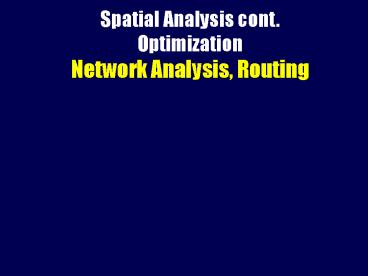Spatial Analysis cont. Optimization Network Analysis, Routing - PowerPoint PPT Presentation
Title:
Spatial Analysis cont. Optimization Network Analysis, Routing
Description:
Microsimulation of neighborhood evacuations in the urban-wildland interface. Environment and Planning A, 34: 2211-2229. Cova, T. J., P. E. Dennison, et al. 2005. – PowerPoint PPT presentation
Number of Views:108
Avg rating:3.0/5.0
Title: Spatial Analysis cont. Optimization Network Analysis, Routing
1
Spatial Analysis cont.OptimizationNetwork
Analysis, Routing
2
Optimization
- Spatial analysis can be used to solve many
problems of design - A spatial decision support system (SDSS) is an
adaptation of GIS aimed at solving a particular
design problem
3
Lab 5
- Edges, junctions, and weights
4
Lab 5
5
Location-allocation Problems
- Design locations for services, and allocate
demand to them, to achieve specified goals - Goals might include
- minimizing total distance traveled
- minimizing the largest distance traveled by any
customer - maximizing profit
- minimizing a combination of travel distance and
facility operating cost
6
Optimizing Point Locations
- One service location and the goal of minimizing
total distance traveled - The operator of a chain of convenience stores or
fire stations might want to solve for many
locations at once - where are the best locations to add new services?
- which existing services should be dropped?
7
Routing Problems
- Search for optimum routes among several
destinations - Draws on location-allocation
- The traveling salesman problem
- find the shortest (cheapest) tour from an origin,
through a set of destinations that visits each
destination only once
8
Traveling Salesman
9
Traveling Salesman Georgia Tech
http//www.tsp.gatech.edu/maps/
10
Routing service technicians for Schindler
Elevator. Every day this companys service crews
must visit a different set of locations in Los
Angeles. GIS is used to partition the days
workload among the crews and trucks (color
coding) and to optimize the route to minimize
time and cost.
11
Optimum Paths
- Find the best path across a continuous surface
- between defined origin and destination
- to minimize total cost
- cost may combine construction, environmental
impact, land acquisition, and operating cost - used to locate highways, power lines, pipelines
- requires a raster representation
12
Example Santa Ynez Mtns., CA
More details at http//www.ncgia.ucsb.edu/ashton/
demos/chuck95/stochastic.html Chuck Ehlschlaeger,
Ashton Shortridge
13
Least-cost path problem. Range of solutions
across a friction surface represented as a
raster. The area is dominated by a mountain
range, and cost is determined by elevation and
slope.
14
Solution of the least-cost path problem. The
white line represents the optimum solution, or
path of least total cost. The best route uses a
narrow pass through the range. The blue line
results from solving the same problem using a
90-m DEM.
15
Optimization Routing for Emergency/Disaster
ResponseSanta Barbara, Utah, San Diego
16
Optimization Routing for Emergency/Disaster
Response
- Kim et al. 2006 PARs, Protective Action Recs
d interpolated, shortest-distance of wildfire to
community d1 shortest distance before PAR d2
shortest distance after PAR t time PAR was
issued t1 time last known fire perimeter at
d1 t2 time last known fire perimeter at d2
17
Fire Origin to CommunitiesEstimate Avg. Speed
of Fire Between Known Perimeters
Kim et al. 2006
18
Animations
19
Gateway to the Literature
- Cova, T. and Johnson, J.P., 2002. Microsimulation
of neighborhood evacuations in the urban-wildland
interface. Environment and Planning A, 34
2211-2229. - Cova, T. J., P. E. Dennison, et al. 2005. Setting
wildfire evacuation trigger points using fire
spread modeling and GIS. Transactions GIS, 9(4)
603-617. - Kim, T.H., Cova, T.J., and Brunelle, A., 2006.
Exploratory map animation for post-event analysis
of wildfire protective action recommendations.
Natural Hazards Review, 7(1) 1-11. - Monteiro, C., Ramirez-Rosado, I.,
Zorzano-Santamaria, P. and Fernandez-Jimenez,
L.A., 2005. GIS spatial analysis applied to
electric line optimization. IEEE Transactions on
Power Delivery, 20(2) 934-942.
20
(Extra slide) Cova et al. 2005































